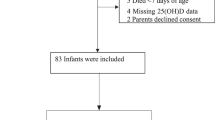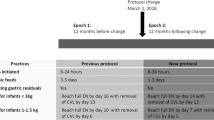Abstract
OBJECTIVE:
Vitamin E is required by very low birth weight (VLBW) infants to prevent vitamin E deficiency. However, prolonged intravenous intakes of vitamin E >4 international units (IU)/kg/day often yield potentially toxic serum tocopherol levels. This study was designed to assess the frequency of potentially inadequate or excessive doses of intravenous vitamin E in parenteral nutrition for VLBW infants in the US.
STUDY DESIGN:
A questionnaire was sent to the 100 neonatal–perinatal training program centers listed in the 2003 directory (American Academy of Pediatrics (AAP)). Using the information provided for each neonatal unit, we calculated the doses of vitamin E (IU/kg/day) that would have been given to infants with body weights of 0.5, 1.0 and 1.5 kg in that unit. The doses were then recoded as inadequate if less than recommended (2.8 IU/kg/day, maximum 7 IU/day) by the American Society for Clinical Nutrition and the AAP, and excessive if >4 IU/kg/day, and frequencies were compared using χ2 analysis.
RESULTS:
The 65 centers that responded were predominantly among those that offered the highest level of subspecialty neonatal intensive care (level IIID). The predicted dose of vitamin E had a median value of 2.8 IU/kg/day for all three weights, and was no significantly different among the three weights. VLBW infants with weights of 0.5, 1.0 and 1.5 kg were predicted to receive doses <2.8 IU/kg/day in 12, 12 and 19% of the neonatal intensive care units (NICUs), respectively, and doses >4 IU/kg/day in 40, 31 and 10% of the NICUs, respectively. Excessive doses were significantly associated with body weight, with more frequent excessive doses at lower weight (p=0.0008).
CONCLUSION:
This survey showed a lack of uniformity of dosing of intravenous vitamin E in VLBW infants. The smallest infants (<1.0 kg) were receiving excessive, potentially toxic doses of vitamin E in a significant number of NICUs in the US in 2003.
This is a preview of subscription content, access via your institution
Access options
Subscribe to this journal
Receive 12 print issues and online access
$259.00 per year
only $21.58 per issue
Buy this article
- Purchase on Springer Link
- Instant access to full article PDF
Prices may be subject to local taxes which are calculated during checkout
Similar content being viewed by others
References
Committee on Nutrition. Nutritional needs of preterm infants. In: William J Klish, editor. Pediatric Nutrition Handbook. 4th ed. Elk Grove Village, IL: American Academy of Pediatrics; 1998. p. 55–87.
Greene HL, Hambidge M, Schanler R, Tsang RC . Guidelines for the use of vitamins, trace elements, calcium, magnesium, and phosphorus in infants and children receiving total parenteral nutrition: report of the Subcommittee on Pediatric Parenteral Nutrient Requirements from the Committee on Clinical Practice Issues of the American Society for Clinical Nutrition. Am J Clin Nutr 1988;48:1324–1342.
Committee on Nutrition. Nutritional needs of the preterm infant. In: Kleinman RE, editor. Pediatric Nutrition Handbook. 5th ed. Elk Grove Village, IL: American Academy of Pediatrics; 2004. p. 23–54.
Astra Pharmaceuticals. M.V.I.® Pediatric™ package insert. http://www.mvi-us.com/pdf/newsline_vol6num4.pdf, accessed 4/28/04.
Sabec Inc. Infuvite Pediatric™. Multiple vitamins for infusion. Package insert. http://www.fda.gov/cder/foi/label/2001/21265s1lbl.pdf, accessed 4/28/04.
Brion LP, Bell EF, Raghuveer TS, Soghier LM . What is the appropriate intravenous dose of vitamin E for very low birth weight infants? J Perinatol 2004;24:205–207.
Raju TN, Langenberg P, Bhutani V, Quinn GE . Vitamin E prophylaxis to reduce retinopathy of prematurity: a reappraisal of published trials. J Pediatr 1997;131:844–850.
Brion LP, Bell E, Raghuveer T . Vitamin E supplementation for prevention of morbidity and mortality in preterm infants (Cochrane Review). In: The Cochrane Library, Issue 4 2003. Chichester, UK: John Wiley & Sons, Ltd.
Amorde-Spalding K, D'Harlingue AE, Phillips BL, et al. Tocopherol levels in infants < or=1000 grams receiving MVI pediatric. Pediatrics 1992;90:992–994.
Phillips B, Franck LS, Greene HL . Vitamin E levels in premature infants during and after intravenous multivitamin supplementation. Pediatrics 1987;80:680–683.
Alade SL, Brown RE, Paquet Jr A . Polysorbate 80 and E-Ferol toxicity. Pediatrics 1986;77:593–597.
Bove KE, Kostmetatos N, Wedig KE, et al. Vasculopathic hepatotoxicity associated with E-Ferol syndrome in low-birth-weight infants. JAMA 1985;254:2422–2430.
Darlow BA, Graham PJ . Vitamin A supplementation for preventing morbidity and mortality in very low birthweight infants (Cochrane Review). In: The Cochrane Library, Issue 4, 2003. Chichester, UK: John Wiley & Sons, Ltd.
Acknowledgements
We thank Rita Gray for her help in contacting the centers by telephone and facsimile. We are grateful to the neonatologists and pharmacists who have responded to our survey. These data were published in an abstract form (Pediatric Research 2004;55: 447A) and presented at the Annual Meeting of the Eastern Society for Pediatric Research at Old Greenwich, CT, 3/27/04, at the US Cochrane Center Collaboration Meeting, Brown University, Providence, RI, 4/1/04, and at the Annual Meeting of the Society for Pediatric Research in San Francisco, CA, 5/1/04.
Author information
Authors and Affiliations
Additional information
Conflict of interest: none.
Rights and permissions
About this article
Cite this article
Brion, L., Bell, E. & Raghuveer, T. Variability in the Dose of Intravenous Vitamin E Given to Very Low Birth Weight Infants. J Perinatol 25, 139–142 (2005). https://doi.org/10.1038/sj.jp.7211223
Published:
Issue Date:
DOI: https://doi.org/10.1038/sj.jp.7211223



